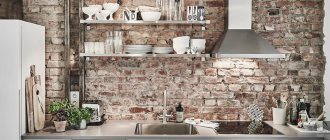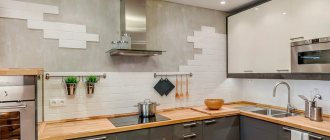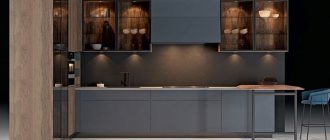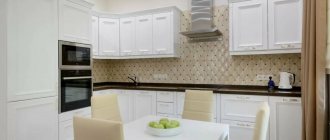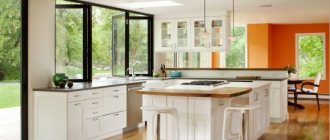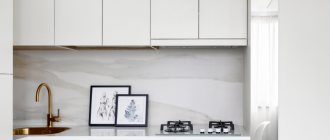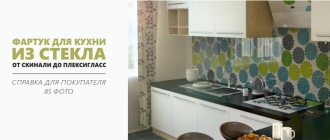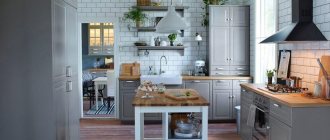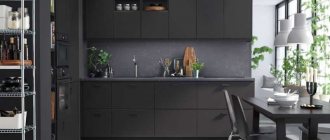Images on photo wallpapers, once popular and lost relevance due to their fragility, returned to interiors several years ago, breaking the stereotypes about drawings on the walls. The variety of subjects, exceptional angles and simply unimaginable decoration possibilities using various technologies made indoor photography the main focus.
Of course, wallpaper remained a priority for living rooms and bedrooms, giving way to more functional and durable materials in the kitchen. Wall solutions in this room must be moisture-resistant, resistant to temperature changes, and wear-resistant. Sheet materials that can be installed quickly and easily are becoming increasingly in demand.
In the dining area, narrow panels continue to predominate, because they are convenient because if one of them is damaged, it is enough to simply replace the part, and there is no need to remove the entire finish.
But it is advisable to cover the apron of the working wall in the kitchen with sheet material. Here, on the contrary, narrow panels are not so functional, since dust, grease, dirt accumulate in the seams, and moisture penetrates to deeper levels of the coating.
Among the popular and functional solutions for the apron:
- plastic wall panels;
- MDF;
- HDF;
- Fiberboard;
- glass - they threw it off.
Kitchen apron: what is it and what is it for?
The backsplash is the part of the wall that borders the countertop below and the kitchen cabinets above. Its main function is to protect the wall from splashes of water when washing dishes, greasy steam and high temperatures. It also reduces the number of kitchen design elements. Only a small part of the wall can be covered with cladding.
Fully protective finishing is generally not a cheap option. If there are no cabinets and shelves, you can decorate up to a height of 1-1.5 meters or up to the baseboard. It all depends on the style and room. When decorating, you can also consider adjacent walls.
Requirements for a kitchen apron
Many people are accustomed to decorating their backsplash with ordinary ceramic tiles. If there are no upper shelves or cabinets and you want to cover the wall to the ceiling, these products can also be used. But there are other materials that can look more harmonious in a room. There are many modern ways to decorate kitchen walls. It is important to remember that the material for the kitchen must have a number of characteristics. Among them it is worth highlighting the following:
- Resistant to moisture. The wall above the kitchen is exposed to moisture. It is exposed to steam when cooking, splashing water when washing hands or dishes. The material should repel and not absorb water. Thus, it does not deform and will last a long time. If it leaks moisture, mold and mildew can form underneath. This may be dangerous to your health. Thus, moisture resistance is one of the most important characteristics that a kitchen carpet should have.
- Resistance to high temperatures and temperature changes. This is the second most important parameter. If the temperature resistance is insufficient, the surface around the slab will quickly deform and lose its attractive appearance.
- Fire safety. This is an important feature that ensures the safety of the finish.
- Environmental friendliness. The material should not release toxic substances even when heated.
- Easy to maintain. The wall above the kitchen worktop may be subject to splashes of food and water. Fatty fumes are dripping from it. All this can quickly lead to contamination of the coating. Therefore, the material should be easy to clean and resistant to aggressive household chemicals.
- Resistance to mechanical damage. The finish should not have dents or cracks from accidental impacts. It must be scratch resistant.
- Durability. The finish should last more than one year. The service life of the cladding largely depends on the properties of the material, such as resistance to moisture, heat, etc.
Zone dimensions
The standard height of the apron is 50-60 cm, depending on the height of the household and the type of tile used. If tiles are used, the standard is 30+30+0.1 cm, since 30 cm is the height of the tiles plus the seam between them. Although these days this rule is not strict, and tile sizes are numerous.
If the cornices are not built-in, they are placed at a distance of 70-80 cm from each other, which means that the apron will be higher. This is important to consider if you are going to make a glass splashback because then it will be a little more expensive to make or you will have to do something to the wall between the edge of the glass and the hood.
When calculating the height, leave 2-3 centimeters of overhang at the top so that the backsplash extends beyond the cabinets.
The work surface should run along the entire perimeter of the kitchen, and not be limited to islands behind the sink and stove. Although water and dirt are more likely to get behind the sink and stove, other areas are still unsafe. This is not a place where you can save money.
If your sink is in the corner of the kitchen, choose a backsplash and a perpendicular wall - the areas around the sink are always the dirtiest.
Design and color
The color of the splashback itself is important for kitchen design, but not for practicality. There are many types of stains in the kitchen, so no matter what color backsplash you choose, there will be stains that will contrast.
Therefore, the most important thing in an apron is texture. The texture cannot be uniform, as any stain will be immediately noticeable. Conversely, on contrasting and heterogeneous textures, small spots are not visible at all. It is optimal to imitate various natural materials: concrete, marble, wood, stone. Or any pattern, and in 2021 patterns have become fashionable and are often used in Scandinavian-style kitchens.
Light tiles are much more practical than dark ones, since most stains are wet, and salt stains remain after the water has dried. While light-colored tiles are a good option, the grout color for your backsplash should not be white. Darker shades of gray are best in terms of appearance and practicality (article on gray kitchens). White tiles with dark gray grout look very good:
If you want something bright, check out the earlier photos of the curtains in the kitchen and separately with the patio doors. Leather and textiles are the two best accents that should go hand in hand.
If you are going for a monochrome kitchen, remember that you will always have a lot of kitchen utensils that are not always easy to find in black and white. A good idea is to combine a monochrome kitchen with shades of green, such as light green. This natural combination is always on trend, and best of all, the salad comes with a lot of kitchen utensils, such as cutting boards, oven mitts, hob, etc. There is an interesting combination: a white kitchen with a wooden countertop and a glass splashback with a picture of grass underneath. Complete borrowing of colors from nature.
Important Tips
There are a number of things to consider when planning the size of your splashback. For example, the apron must extend a few centimeters under the installed headset.
Using a plinth, it is also recommended to protect the joint formed between the tabletop and the apron itself.
Otherwise, water will constantly flow onto the lower cabinets, which will soon lead to the formation of fungus.
- How to decorate the Easter table - ideas, tips for decorating the Easter table, photos
How to decorate a table for March 8: photo of table setting, decoration of dishes
Curtains for the kitchen with a balcony door: how to choose the ideal option
When decorating a backsplash, you should never use various porous materials, such as unglazed ceramic tiles.
Otherwise, large quantities of moisture will constantly accumulate in the pores. In addition, washing such a surface will be extremely inconvenient, and after a while mold will appear.
It is best to choose an even, smooth apron without prominent joints and seams, because they usually also contain various dirt and moisture, and cleaning them means wasting a lot of free time, which, on top of everything else, is quite difficult to do.
What other materials can be used?
This concludes the basic ideas about how to decorate an apron. Below are just a few very original options.
Chalkboard paint
A very original method is to make a slate slab instead of an apron. Simply cover the required area three times with chalkboard paint. It is easy to care for: avoid abrasive detergents and rough sponges.
Using a drawing on a board, you can change the look of your kitchen every day, and you definitely won’t get tired of it. It will look especially impressive in a white kitchen.
Brick
Natural brick or gesso are simply not suitable for backsplashes due to the porosity of the material: liquids and dirt will stick to the surface like a sponge and will be difficult to wash off.
Glass comes to the rescue again and protects this interesting design solution. The texture of the brick will be lost, so it is best to move the element away from the cooking area.
Oilcloth
Yes, you can make an apron out of oil fabric. This is one of the cheapest options you can make yourself. All you need to do is take the necessary measurements, select the oilcloth itself, and then attach it to the wall using a furniture stapler.
This option will save the walls from dirt and water, but for a gas stove it is better to choose another option - the oiler can also become charred.
Choosing the best apron for a given situation is not easy. Most often, people are guided only by aesthetics, but do not forget about other considerations:
- Budget;
- Planned period of use;
- Kitchen style;
- Difficulty of reconstruction and replacement;
- cleaning.
Focus on these factors and you'll enjoy your apron for years to come.
Acrylic
Roughly speaking, acrylic is a plastic that can imitate marble or oak. It is cheaper than stone, but is still an expensive option. Acrylic panels are connected virtually seamlessly, so hygiene is not an issue. Acrylic itself is a good material: it does not fade, does not fade, does not leave stains and is durable. Like glass, it gives enormous scope for imagination. But since it is based on polymers, it has certain limitations:
- it can melt next to the stove because it is afraid of high temperatures;
- does not like aggressive and abrasive detergents.
Acrylic looks great in the kitchen, for example, on facades, but is not the best choice for a backsplash.
Laminate or parquet
Laminate is preferred for use on backsplashes and is often cheaper than parquet. It is worth choosing high-class material (32-33) and good locks with moisture protection. You will have to install it yourself, since ready-made laminated panels for the apron are not sold. Installed using liquid nails.
A parquet apron is made differently: first, the “planks” are attached to the substrate with glue or liquid nails, then everything is varnished and also attached to the wall. But the varnish can melt or crack on the deck, so this method isn't for everyone. You can also cover the parquet with glass, but then the apron will be too thick - this is not suitable for everyone. But it looks very original.
Wallpaper
We are not talking about standard options, which are not very suitable for a kitchen apron, but about fiberglass wallpaper. It is durable and strong, and is resistant to extreme temperatures and moisture. There are many different textures available, but a uniform finish with no obvious unevenness is most suitable.
Gluing is no different from the usual process - level and prime the wall, then carefully adjust the fragments and level the surface. Let dry for a while and then coat with washable, waterproof paint. Then you can change the color at least twice a year, which is very convenient, because if you change the furniture, you won’t have to redo the apron.
Wine corks
Yes, that's right - they line the apron with wine corks. They not only collect them themselves, but also buy them (!) in bars and restaurants. To speed up the process, they are cut in half - this makes it easier to glue them to the ground.
The installation method is the same as for parquet flooring. Only corks are porous, so cleaning them will be a big problem. You can resort to an invariable assistant - glass, but is it worth adding it to an already thick apron? Wine stoppers are a good idea for the dining room, but not for the kitchen countertop.
Pebbles
If you love rocky beaches, you can create one in your kitchen. For example, an apron. But since the surface of the stone is not uniform, and it will be very difficult to clean it, dust will get between the stones, and as a result, such a panel will quickly lose its original appearance.
Comparison of different materials
The material from which the kitchen apron is made is selected depending on what the customer considers to be the key parameters
- practicality and ease of care
- moisture resistance
- high temperature resistance
- self-assembly and disassembly
- durability
- appearance
- cost of materials and installation
The cheapest option is to line the kitchen working wall with plastic, MDF or laminate. Mosaic, stone and Italian ceramics are the most expensive options.
Glass, metal or mirrors are creative options, but you must be prepared to keep them clean. To make a kitchen screen both practical and beautiful, finishes are often combined.
An interesting solution is to cover the stone or pebble apron around the stove and sink with glass panels. Another option is a combination of ceramics in active cooking areas and MDF above the dining area.
Before choosing a wall panel
For example, install wall panels for the kitchen instead of old tiles. When choosing this type of coating, you need to know their pros and cons. First you need to know: the panel can be made of different materials.
Here is a list of the types of sheet panel material: plastic; tree; metal; stone; glass; decorative rock; wood-based panels of various types.
Each of these types of panels can be of different models, styles, and colors. Can be large or smaller. Some types are laminated. In addition to sheet panels, slatted panels are also produced.
Color composition for an apron
Colors play an aesthetic role in the interior of the kitchen. A variety of colors can make or break the design direction of a room. Therefore, the choice of color is approached from a practical point of view.
Lilac kitchen
For a sophisticated lilac kitchen, soft shades such as pink, blue, light gray and white work well.
You can also choose a darker version of the dominant shade. Dark purple mosaic tiles are the perfect complement to the lilac set.
Pairing this color with dark gray also looks good, especially if you match it with kitchen appliances. This is a universal option: it is discreet and at the same time attracts attention.
Shiny lilac elements also pair well with matte blue tiles. The play of contrasts creates an interesting effect, making the kitchen seem larger and more spacious. It looks especially stylish in combination with light-colored countertops.
Cappuccino color
Do you want a kitchen with cappuccino? Choose more muted, elegant shades. Try a tone-on-tone finish.
It looks great, especially in the right lighting. But keep in mind: it is better not to use it in small rooms.
You might like the boa constrictor tiled splashback in several adjacent shades. But it’s better not to experiment with bright colors - coffee shades are quite delicate, and any dominant color can simply “overload” them.
White color for apron
All shades of white - cream, with a bluish tint, cream with pinkish notes - are used as a contrast to dark colors. They are most often used in high-tech and Scandinavian kitchens.
What should an apron go with in the kitchen?
Let's analyze element by element what a kitchen apron should be combined with.
Partial combination with kitchen facades
You can even highlight a specific part of the backsplash in the same color as the front panels. For example, highlight the kitchen area in the same color as the facades. This color can be repeated in mosaic tiles, in some places repeating the color of the facades. This technique helps to unite and diversify the room.
In the same tone as the walls
This is an ideal option for a kitchen-living room, where the emphasis is on the living room and not on the kitchen work area. In this case, do not lay tiles on the apron, but decorate it, for example, with a glass panel or paint the wall in this area with special moisture-resistant paint.
Principle of opposites
This is a bold decision that will help diversify your space. Use contrasts: dark and light, matte and glossy, patterned and smooth. Use a plain façade and rich, bright yellow elements. It is the central element of the interior. To make the room look harmonious, add a few accents in the form of mugs, a rug or a vase in the same yellow color. However, do not overdo it with bright colors, otherwise the kitchen will look cheap. You can do it simpler and add a matte dark gray apron to the mother-of-pearl facades. With the right choice, such a kitchen will look expensive.
There are two colors in the kitchen
If you have a two-tone kitchen, then the color of the backsplash either matches the color of the walls, or is halfway between the walls and the floor. If the apron is darker than the walls, it will “heavien” the room, and if it is lighter, it will conflict with them.
Combination with furniture
Choose, for example, cream fronts with an oak apron. This element may overlap with chairs made of the same material, table legs, decorative panels on the wall or the color of the sofa. You can choose sophisticated shades that are in fashion today. These are the shades that designers prefer in modern interiors. The pink ash-colored product can echo the seats of comfortable armchairs. You can use shades with beautiful names, for example, coffee with milk or azure gray.
Apron under the countertop
The simplest option. Ideally, a kitchen apron should not only match the color of the countertop, but also be made of the same material (although this is not necessary, for example, the countertop can be made of wood, and the apron can be made of a PVC panel of a similar shade of wood). It looks even and harmonious.
If there is no suitable picture in the catalog of glass aprons for the kitchen?
Is the required image missing from the kitchen skin catalog? No problem! You have the opportunity to find a suitable picture on the Internet. Our designers will search for a sample in good quality for printing and edit the design you like from a catalog of glass kitchen aprons, for example, on Shutterstock.
The InterGlass interior glass studio offers a subscription to the largest photo banks with high-quality catalogs of images for the skin. Photobank is a collection of top quality photos where professional designers and photographers post their work: where you can find the picture you need and download it! When ordering a tempered glass apron with photo printing, the pictures are free!
Photobank sites:
- shutterstock
- fotolia (Photolia)
- istockphoto
- depositphotos (Depositphotos)
- bigstockphoto
- dreamstime
- 123rf (123рф)
Not all images for glass kitchen splashbacks are included in the catalogue. Some are in the archives, some have not yet been added to the site, and some need additional adjustments before publication. You can view and download an expanded catalog of images of skins for a glass kitchen apron using the link (YandexDisk)
InterGlass Image Bank
Installation of a kitchen apron
The decision on the method of laying the coating depends on the chosen material:
- In the case of coatings such as stone, decorative formwork or mosaic structures, you will need not only the help of a specialist. In this case, leveling and plastering the walls will be a mandatory part of the repair work.
- Plastic panels, MDF and some types of tiles do not require pre-treatment.
In other cases, the amount of preparatory work depends on the quality of the wall cladding, possible structural defects and whether the apron has a complex pattern.
The apron over the hob is an extremely important part of the kitchen interior. The decorative surface performs not only a practical, but also an aesthetic function, emphasizing style.
Panel fastening safety
The purchased panels must be secured. You need to know how to attach a wall panel. To be strong and safe. It is best to attach it to the sheathing. It's done like this. Wooden slats or metal are used. Concrete is drilled in the right places. The slats are mounted on the wall.
Using screws, they are fixed in concrete. Since wood can rot, smart people came up with the idea of covering wooden sheathing with insulating materials used to insulate the foundations of dachas during construction.
Then the sheathing sits firmly on the wall, and the panels are easy to attach to the frame. Without fear for the wooden base. If there is a decision to make a metal grate, then steel is better. A high-quality frame is guaranteed. But there is an easier way to attach it.
This is to attach the panels to the wall immediately. Prepare the fastening. And screw the panels directly onto the wall. You can also glue it. To do this, concrete is prepared and primed several times. Then you can apply modern sealants. Stick the panel. Press until dry. But it would still be better to mount it with lathing.
